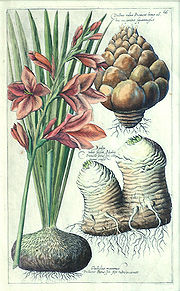
Emanuel Sweert
Encyclopedia


Sweert lived in a period when new plants from across the world were being introduced to Europe via Dutch, English and French ships. To meet the burgeoning interest in plants by the public, nurseries were being established by wealthy merchants in order to meet the demand. Botanical illustration suddenly found a new outlet in the production of nursery catalogues. Sweert prepared his Florilegium as a guide of his available stock for the Frankfurt Fair of 1612. The plates, depicting some 560 bulbs and flowers, were from the Johann Theodore de Bry Florilegium which in turn was based on that by Pierre Vallet. His attractively depicted bulbs sparked their popularity, leading to 6 editions of the work between 1612 and 1647, and a demand which would later result in "Tulipomania
Tulip mania
Tulip mania or tulipomania was a period in the Dutch Golden Age during which contract prices for bulbs of the recently introduced tulip reached extraordinarily high levels and then suddenly collapsed...
". At the time of the fair Sweert was in the employ of Emperor Rudolf II
Rudolf II, Holy Roman Emperor
Rudolf II was Holy Roman Emperor , King of Hungary and Croatia , King of Bohemia and Archduke of Austria...
as head of his gardens in Vienna
Vienna
Vienna is the capital and largest city of the Republic of Austria and one of the nine states of Austria. Vienna is Austria's primary city, with a population of about 1.723 million , and is by far the largest city in Austria, as well as its cultural, economic, and political centre...
. He borrowed freely from plates that had been published before, so that many of those that appeared in the Florilegium had been cultivated in Henry IV
Henry IV of France
Henry IV , Henri-Quatre, was King of France from 1589 to 1610 and King of Navarre from 1572 to 1610. He was the first monarch of the Bourbon branch of the Capetian dynasty in France....
's gardens at the Louvre
Louvre
The Musée du Louvre – in English, the Louvre Museum or simply the Louvre – is one of the world's largest museums, the most visited art museum in the world and a historic monument. A central landmark of Paris, it is located on the Right Bank of the Seine in the 1st arrondissement...
.
Sources
- Emmanuel Sweert at the Netherlands Institute for Art History

